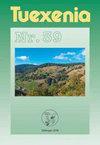Phytocoenological analysis of grey alder (Alnus incana L.) forests in the Dinarides of Croatia and their relationship with affiliated communities
IF 1.1
4区 生物学
Q3 PLANT SCIENCES
引用次数: 2
Abstract
This paper provides a comprehensive survey of the results of phytocoenological research into Alnus incana forests from the alliance Alnion incanae in the Dinarides. Stands from the south-eastern Dinar-ides (Alnetum incanae = Oxali-Alnetum incanae) were analyzed and compared with those from the north-western Dinarides (Lamio orvalae-Alnetum incanae). The comparison reveals significant differ-ences in the floristic composition and in the degree of differentiation – and particularly in the presence of the species of the Illyrian floristic geoelement. Focus was placed on the area of western Croatia where a geographic variant of Helleborus dumetorum had previously been de-fined within the association Lamio orvalae-Alnetum incanae. Two of its subtypes, Salix alba and Alnus glutinosa, were determined in our research. The former subtype thrives on occasionally flooded, moist sites, where the floristic composition is dominated by hygrophytes. The latter subtype grows on elevat-ed and drier terraces and is richer in mesophilous species from the surrounding zonal forests. A floris-tic-sociological comparison of the Lamio orvalae-Alnetum incanae with the related syntaxa indicates the presence of about fourty diagnostic species which accentuate its independence and the need to assess it at the level of an independent, regional association within the alliance Alnion incanae.克罗地亚Dinarides地区灰桤木(Alnus incana L.)林的植物群落学分析及其与附属群落的关系
本文全面综述了Dinarides地区银桤木(alunion incanae)林的植物群落学研究成果。对东南Dinarides (Alnetum incanae = Oxali-Alnetum incanae)的林分与西北Dinarides (Lamio orvalae-Alnetum incanae)的林分进行了分析和比较。这种比较揭示了在植物区系组成和分化程度上的显著差异,特别是在伊利里亚植物区系地质元素的种类方面。重点放在克罗地亚西部地区,在那里,以前在Lamio orvalae-Alnetum incanae协会中定义了一种地理变异的Helleborus dumetorum。在我们的研究中确定了它的两个亚型,Salix alba和Alnus glutinosa。前一个亚型在偶尔淹水的潮湿地点生长,那里的区系组成以湿生植物为主。后一个亚型生长在高海拔和干燥的梯田上,富含来自周围地带性森林的中温植物。对Lamio orvalae-Alnetum incanae与相关句法群进行的花卉社会学比较表明,存在大约40种诊断种,这突出了其独立性,并且需要在incanae联盟内独立的区域协会的水平上对其进行评估。
本文章由计算机程序翻译,如有差异,请以英文原文为准。
求助全文
约1分钟内获得全文
求助全文
来源期刊

Tuexenia
PLANT SCIENCES-
CiteScore
2.80
自引率
25.00%
发文量
0
期刊介绍:
Tuexenia publiziert Original- und Übersichtsarbeiten sowie Berichte zu Themen der Geobotanik / Vegetationsökologie und zu Nachbarwissenschaften wie Populationsökologie, Biodiversitätsforschung, Biozönologie, Renaturierungsökologie und ihren Anwendungen, vor allem im Naturschutz. Der geografische Schwerpunkt liegt in Zentraleuropa und angrenzenden Regionen.Tuexenia erscheint jährlich in einem Band, der etwa zur Jahresmitte fertig gestellt wird. Autoren erhalten von jeder Arbeit eine PDF-Datei und gemeinsam 20 Sonderdrucke kostenlos.
Die Qualität der wissenschaftlichen Manuskripte wird durch die Redaktion und einen Wissenschaftlichen Beirat (Peer Review) gesichert (s. auch die Manuskript-Richtlinien vor dieser Seite). Es werden keine Druckkosten erhoben. Tuexenia legt Wert auf allgemeine Online-Verfügbarkeit der Beiträge.
 求助内容:
求助内容: 应助结果提醒方式:
应助结果提醒方式:


